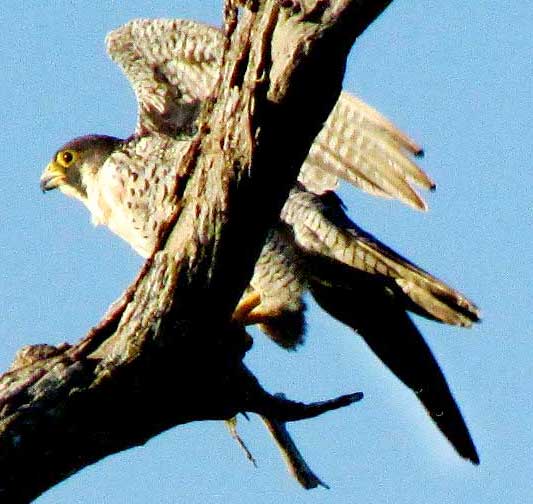Excerpts from Jim Conrad's
Naturalist Newsletter
from the November 30, 2014 Newsletter issued from Río Lagartos, on the Yucatan Peninsula's northern coast (~N21.60°, ~W88.16°), Yucatán state, MÉXICO
PEREGRINE FALCON
I've always regarded Peregrine Falcons, FALCO PEREGRINUS, as rare, and it's true that they were virtually eradicated from eastern North America by pesticide poisoning, especially from the use of DDT, in the middle 20th century. But a major conservation effort was made and now in many large cities and coastal areas they're regularly seen. Most trips I make up the estuary here I see one or more and, below, one is shown about to take flight:

You know you have a Peregrine Falcon when it's a big, heavily built falcon with a dark cap and streak below the eye -- ta "mustache." They're very distinctive looking birds but sometimes people confuse them with the much more common Kestrel, because of the similar shape and facial pattern, both with mustaches. The little Kestrel is only 8.5 inches long (22cm), while the Peregrine is nearly twice as long, 15 inches (38cm), but in the field sometimes it's hard to judge size. Kestrels show a rusty back, but there's no rustiness on the Peregrine.
Peregrines hunt almost exclusively medium-sized birds such as pigeons and doves, waterfowl, songbirds, and waders, but they're also known as killing the largest diversity of birds of any other North American raptor -- with over 300 bird species having been documented as Peregrine prey, including nearly 100 kinds of shorebird.
Peregrine Falcons are one of a few birds with an essentially worldwide distribution, though they're still absent from large parts of their former area. Having such an enormous distribution, their population is evolving into subspecies, each subspecies with adaptations for their own part of the world. Nowadays 19 subspecies are recognized.
from the November 13, 2006 Newsletter issued from Río Lagartos, on the Yucatan Peninsula's northern coast (~N21.60°, ~W88.16°), Yucatán state, MÉXICO
A SEAGULL-EATING PEREGRINE FALCON
Friday I heard from my old friend Sandro. When he needs money he signs on as a crewmember on a big fishing trawler in northern waters. He wrote that, apparently because of global warming, during this last fishing season his ship had fished exceptionally far north -- "about 60/90 miles off Cape Navarin Russia just north of the peninsula of Kamtchaka."
Then he told me how one day the crew started talking about "some kind of hawk or a falcon eating seagulls on the bow... I observed the pajarito everytime I had a chance, and boy let me tell you that he kept a full belly, all he did was hunting and go eat on top of one of the spare nets that we had on the bow, this lasted for about 5 days and then he left."
Sandro managed to get a snapshot of the seagull-eater smugly perched on a heap of netting, and he sent the picture to me.
It was an immature Peregrine Falcon, an Arctic subspecies. I showed the picture to Diego, Río Lagartos's master bird-guide, expressing my surprise that any raptor would eat a seagull. Diego said that Peregrine Falcons overwinter here, he's already begun seeing this year's crop, and he's seen them attack seagulls here.
"In mid-air he hits into the gull with his shoulder, then before the gull can get its balance the falcon has circled back and put its talons into it."
I've seen Peregrin Falcons referred to as "the planet's fastest animal," and I've seen what a blur they are when they pass by, so I have no doubt that they could take advantage of a clumsy old seagull suddenly shouldered out of the sky.